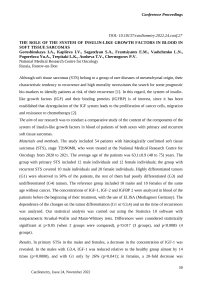The role of the system of insulin-like growth factors in blood in soft tissue sarcomas
Автор: Goroshinskaya I.A., Kaplieva I.V., Sagatelyan S.A., Frantsiyants E.M., Vashchenko L.N., Pogorelova Yu.A., Trepitaki L.K., Ausheva T.V., Chernogorov P.V.
Журнал: Cardiometry @cardiometry
Статья в выпуске: 24, 2022 года.
Бесплатный доступ
Although soft tissue sarcomas (STS) belong to a group of rare diseases of mesenchymal origin, their characteristic tendency to recurrence and high mortality necessitates the search for some prognostic bio-markers to identify patients at risk of their recurrence [1]. In this regard, the system of insulinlike growth factors (IGF) and their binding proteins (IGFBP) is of interest, since it has been established that dysregulation of the IGF system leads to the proliferation of cancer cells, migration and resistance to chemotherapy.
Короткий адрес: https://sciup.org/148326320
IDR: 148326320 | DOI: 10.18137/cardiometry.2022.24.conf.27
Текст статьи The role of the system of insulin-like growth factors in blood in soft tissue sarcomas
National Medical Research Centre for Oncology
Russia, Rostov-on-Don
Although soft tissue sarcomas (STS) belong to a group of rare diseases of mesenchymal origin, their characteristic tendency to recurrence and high mortality necessitates the search for some prognostic bio-markers to identify patients at risk of their recurrence [1]. In this regard, the system of insulinlike growth factors (IGF) and their binding proteins (IGFBP) is of interest, since it has been established that dysregulation of the IGF system leads to the proliferation of cancer cells, migration and resistance to chemotherapy [2].
The aim of our research was to conduct a comparative study of the content of the components of the system of insulin-like growth factors in blood of patients of both sexes with primary and recurrent soft tissue sarcomas.
Materials and methods . The study included 54 patients with histologically confirmed soft tissue sarcomas (STS), stage T2bN0M0, who were treated at the National Medical Research Centre for Oncology from 2020 to 2021. The average age of the patients was 63.1±0.9 (48 to 75) years. The group with primary STS included 12 male individuals and 12 female individuals; the group with recurrent STS covered 10 male individuals and 20 female individuals. Highly differentiated tumors (G1) were observed in 50% of the patients, the rest of them had poorly differentiated (G3) and undifferentiated (G4) tumors. The reference group included 10 males and 10 females of the same age without cancer. The concentrations of IGF-1, IGF-2 and IGFBP 2 were analyzed in blood of the patients before the beginning of their treatment, with the use of ELISA (Mediagnost Germany). The dependence of the changes on the tumor differentiation (G1 or G3,4) and on the time of recurrences was analyzed. Our statistical analysis was carried out using the Statistica 10 software with nonparametric Kruskal-Wallis and Mann-Whitney tests. Differences were considered statistically significant at p<0.05 (when 2 groups were compared), p<0.017 (3 groups), and p<0.0085 (4 groups).
Results. In primary STSs in the males and females, a decrease in the concentration of IGF-1 was revealed. In the males with G3.4, IGF-1 was reduced relative to the healthy group almost by 14 times (p=0.0000), and with G1 only by 26% (p=0.041); in females, a 20-fold decrease was observed, independent of the tumor differentiation. Only a slight decrease in the IGF-2 level was noted that led to a drop in the IGF-1 / IGF-2 ratio in the males with G3.4 by 8.8 times and in all females by 24.3 times. With recurrent STSs in the males, there was a decrease in the IGF-1 level by 40.4% (p=0.0001) and in the IGF-2 level at G3.4 by 19.3% (p=0.0027), while at G1 the IGF-2 concentration even exceeded the level of donors by 9.4 (p=0.0017). In the females with the recurrences, there was a decrease in the IGF-1 level by 78.2-85.5% (p ≤ 0.0003) and an increase in the IGF-2 level by 20.9-57.8% (p ≤ 0.04) relative to the concentrations of these ligands in healthy women, whereas both processes were found more pronounced in case of a slow process of recurrence. IGF-2 levels in relapses exceeded the levels in primary STSs by 63-113% (p<0.004). Blood levels of IGFBP2 in all females with primary STSs increased by more than 3 times, while in recurrences the protein level increase depended on both tumor grade and the time to recurrence.
With a rapid recurrence (from 1 to 3 years), the median concentration of IGFBP2 was 2.6 times higher (p = 0.0001) than that recorded in a slow recurrence (more than 3 years), and at G3.4 relative to G1 it was recorded to be 2, 2 times higher (p=0.005). In the males, the increase in IGFBP2 was less pronounced than in the females. Thus, the dependence of an increase in the level of IGFBP2 in the females on the time to recurrence and the STS grade suggested that component of the IGF system as a biomarker of poor prognosis, as it was reported for other cancers [3; 4].
Conclusion . STSs are characterized by changes in the IGF system. The imbalance between the IGF components in blood is most pronounced in patients of both sexes with the G3,4 tumors. The increase in the level of IGFBP2 in STS in all patients and its dependence on the clinical characteristics of the disease, in particular in recurrent processes, indicate the prognostic value of this indicator.
Список литературы The role of the system of insulin-like growth factors in blood in soft tissue sarcomas
- Pillozzi S., Bernini A., Palchetti I. et al. Soft Tissue Sarcoma: An insight on biomarkers at molecular, metabolic and cellular level. Cancers (Basel), 2021, v. 13(12): 3044.
- Mancarella C, Morrione A, Scotlandi K. Unraveling the IGF system interactome in sarcomas exploits novel therapeutic options. Cells, 2021, v; 10(8): 2075.
- Tombolan L., et al. High IGFBP2 expression correlates with tumor severity in pediatric rhabdomyosarcoma. Am J Pathol., 2011, v. 179, p. 2611-2624.
- Tang D., Yao R., Zhao D. et al. Trichostatin A reverses the chemoresistance of lung cancer with high IGFBP2 expression through enhancing autophagy. Sci Rep., 2018, v. 8: 3917.


